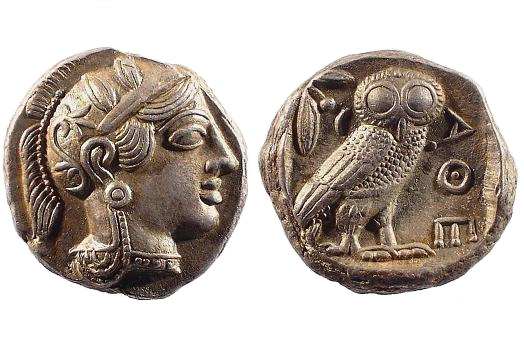
about ancient nomos
Ancient Nomos Art is a museum of galleries exhibiting ancient coins and ancient mint maps. The coin gallery displays the diverse art and history of hand-crafted ancient Greek, Roman, Byzantine, Persian and Medieval coinage. The ancient mints mapping gallery features Greek, Roman, Byzantine, Asia Minor and Medieval mint city regions and territories. Visitor's are welcome to explore, study and enjoy Ancient Nomos Art.

Greek, Attica – 449 BC
Athens
From Ancient Galleries

Obverse: Athena to right wearing crested helmet ornamented with olive leaves.
Reverse: Owl standing right with head facing; olive sprig and crescent behind.
LEGEND SYMBOLS
Obv: Head of Athena facing right with an almond shaped eye, wearing a crested helmet ornamented with three olive leaves over the visor. Rev: Owl standing and facing right with head facing forward, ethnic AΘE to right and olive twig and crescent to left.
The Attica tetradrachms are masterpieces of Hellenic Greek art in coinage. The wide spread hoard evidence indicates this coin was one of the most popular currencies of the ancient world. Historians have noted that the term “owls” was Athenian slang when referring to this popular coin. The wide spread use of the Athenian “owls” during the mid-fifth century was a testament to Athens economic strength, superior shipping and trade in the Aegean, and successful territorial expansions following the wars against Persia. The coins high relief and design style had remained essentially unchanged, though somewhat archaic in appearance, long after other Greek city-states began producing more refined and artistic style coins. During the period between 449 BC and 413 BC, huge quantities of silver were mined and minted into this coinage to help finance many government sponsored programs and building projects, such as the Parthenon. The Athenians also used their vast quantities of currency to help finance the large cost of the Peloponnesian Wars. The obverse typically depicts the head of Athena facing right with an almond shaped eye, wearing a crested helmet ornamented with three olive leaves over the visor and a spiral floral scroll on the bowl. Athena’s hair is drawn across her forehead in even swag-like parallel curves. The reverse depicts an owl standing and facing right with its head facing forward, erect in posture and with a prong tail. According to Greek mythology, the owl is considered Athena’s attribute of wisdom. Athena was also known to transform herself into the form of an owl. To the right of the owl is the Greek ethnic AΘE, the first three letters of the word “AθENAION”, meaning “of the Athenians.” To the left of the owl is an olive twig and crescent shaped symbol. The entire reverse composition is masterfully engraved within an incuse framed square.
DOCUMENTATION
Value: Tetradrachm. Metal: AR Silver. Weight: 16.95 grams. Mint: Athens, Attica. Date: 449 BC.
Attribution: British Museum 62ff; Dewing 1620; Sylloge Nummorum Graecorum Copenhagen 34.
Legend, Documentation and Attribution
